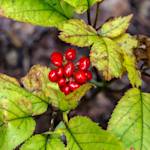Rhizanthella orchids
2020 CE • Australia
The Rhizanthella species of orchid, native to Australia, is characterized by its inconspicuous appearance due to its subterranean growth habit and lacks typical aerial parts such as leaves and stems, earning it the status as one of Australia's strangest flowers. "Rhizanthella has been known to science since 1928, when a farmer in Western Australia who was ploughing mallee for wheat fields noticed a number of tuber-like plants among the roots of broom bushes . . . For much of its life, an underground orchid exists in the soil as a small white rhizome (thickened underground stem). When it flowers, it remains hidden under leaf litter and soil close to the surface, its petals think and pink, its flower head a little larger than a 50 cent coin . . . Its pollinator is probably a tiny fly that burrows down to lay eggs in the orchid, mistaking the flower for a fungus. Today, all Rhizanthella species are vulnerable: the species R. gardneri and R. johnstonii are listed as critically endangered under national environment laws, while R. slateri and and R. omissa are listed as endangered."
Mark Clements, "‘Like finding life on Mars’: why the underground orchid is Australia’s strangest, most mysterious flower," The Conversation, December 28, 2020.
Image: Jean and Fred Hort via Flickr, CC BY 2.0 DEED Attribution 2.0 Generic


Learn about Maya Lin’s fifth and final memorial: a multi-platform science based artwork that presents an ecological history of our world - past, present, and future.

Discover ecological histories and stories of former abundance, loss, and recovery on the map of memory.

Learn how we can reduce our emissions and protect and restore species and habitats – around the world.

See how art can help us rethink the problems we face, and give us hope that each one of us can make a difference.

Help make a global memorial something personal and close to home. Share your stories of the natural world.


